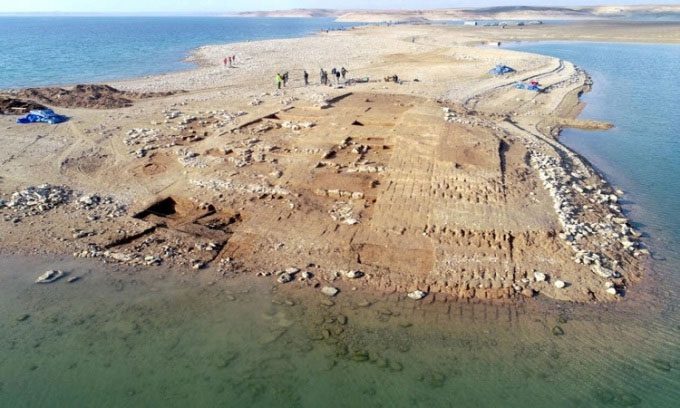A team of German and Kurdish archaeologists has discovered a 3,400-year-old ancient city from the time of the Mittani Kingdom, once situated along the Tigris River.
The ancient urban area emerged from the waters of Lake Mosul earlier this year as water levels rapidly dropped due to severe drought conditions in Iraq. This vast city, which contains a palace and numerous monumental buildings, may be Zakhiku, an important center during the time of the Mittani Kingdom (1550 – 1350 BCE).

Ruins of the Bronze Age city in Lake Mosul. (Photo: University of Tübingen)
Iraq is one of the countries most severely affected by climate change. The southern region has been particularly impacted by prolonged drought lasting for months. To prevent crops from dying, authorities have drawn large amounts of water from Lake Mosul since December of last year. This led to the re-emergence of the Bronze Age city that had been submerged for decades in the Kemune area of Kurdistan, Iraq.
The appearance of the ancient city put archaeologists under sudden pressure to excavate and document as much as possible before the site became submerged again. Dr. Hasan Ahmed Qasim, president of the Kurdish Archaeological Organization, along with Professor Ivana Puljiz from the University of Freiburg and Professor Peter Pfälzner from the University of Tübingen, quickly decided to collaborate on the excavation at Kemune. The excavation took place in January and February 2022 with support from the Department of Antiquities and Heritage in Duhok. The excavation team was formed within days, facing immense pressure as they were uncertain when the water levels would rise again.
In a short period, researchers successfully mapped out most of the city. In addition to a palace, they uncovered other large structures, including a massive fortress with walls and watchtowers, a monument, a multi-story storage building, and an industrial complex. The research team determined that the complex was built during the time when the Mittani Kingdom controlled much of northern Mesopotamia and Syria.
Researchers were astonished by the well-preserved condition of the walls (some reaching several meters high), despite being constructed from sun-dried mud bricks and submerged underwater for over 40 years. Additionally, they discovered five ceramic jars containing more than 100 cuneiform tablets, dating back to the Middle Assyrian period. The team hopes this discovery will provide crucial information about the fate of the city and when the Assyrians began to rule the area.
To prevent damage from rising waters, the excavated buildings were entirely covered with tightly wrapped plastic sheeting and filled with gravel as part of a conservation project funded by the Gerda Henkel Foundation. This method helps protect the earthen walls during periods of flooding.




















































